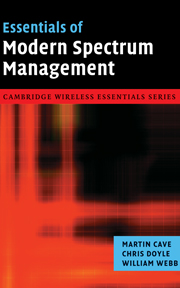Book contents
- Frontmatter
- Contents
- Acknowledgements
- I Emerging problems with the current spectrum management approach
- 1 Current spectrum management methods and their shortcomings
- 2 How changing technology is impacting spectrum management
- 3 Alternative ways of dividing spectrum
- II Markets
- III Regulation
- IV Conclusions
- Further reading
- Abbreviations
- Author biographies
- Subject index
2 - How changing technology is impacting spectrum management
Published online by Cambridge University Press: 13 August 2009
- Frontmatter
- Contents
- Acknowledgements
- I Emerging problems with the current spectrum management approach
- 1 Current spectrum management methods and their shortcomings
- 2 How changing technology is impacting spectrum management
- 3 Alternative ways of dividing spectrum
- II Markets
- III Regulation
- IV Conclusions
- Further reading
- Abbreviations
- Author biographies
- Subject index
Summary
Technology used to lend itself to discrete allocations
Until recently all technologies used a relatively narrow bandwidth and assumed that they were the sole users of that frequency. For example, the GSM mobile phone system transmitted signals with a 200 kHz bandwidth, which at 900 MHz is less than a thousandth of the carrier frequency. The systems were designed assuming that there would be little interference, and where there was it would be carefully controlled by the operator.
The result of the use of these technologies has been to regulate the spectrum by frequency. That is, the spectrum is divided up into discrete parcels of frequency, for example 915–925 MHz, and assigned to a particular user. That user then expects that they will be given exclusive use of the band. This is shown diagrammatically in Figure 2.1, and has been the system on which spectrum management has been based for almost 100 years.
This approach facilitates the same use of spectrum in multiple countries, often known as harmonisation. By aligning the decision as to what the spectrum is to be used for across multiple countries, the same technology, such as GSM, can be deployed. This brings a range of benefits including economies of scale, international roaming and reduced interference. However, it also brings some disadvantages including the need for the regulator to predict the optimum service and technology and tying many countries to the same frequency plan regardless of whether the need differs from country to country.
- Type
- Chapter
- Information
- Essentials of Modern Spectrum Management , pp. 11 - 24Publisher: Cambridge University PressPrint publication year: 2007



